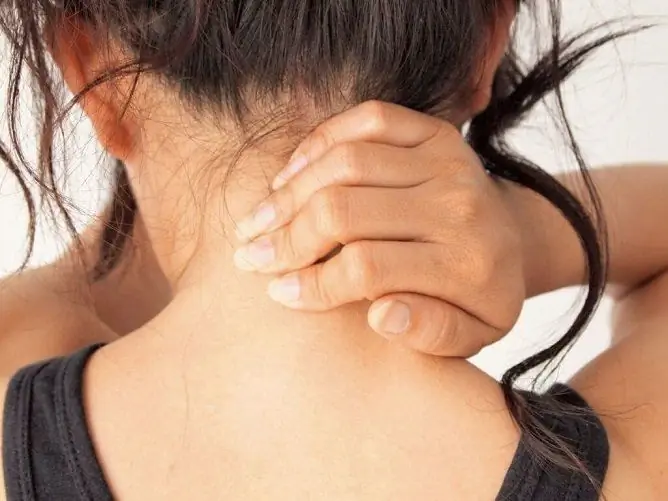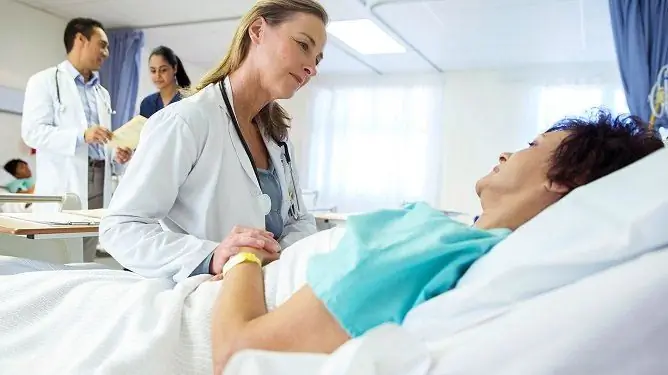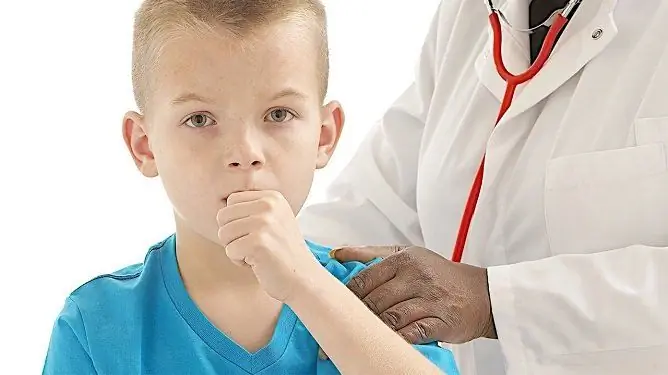- Author Rachel Wainwright [email protected].
- Public 2023-12-15 07:39.
- Last modified 2025-11-02 20:14.
Massage for bronchitis in children and adults
The content of the article:
- Why is chest massage prescribed for bronchitis
- Chest massage for bronchitis
- Massage for bronchitis in adults at home
- Massage for bronchitis in children
- Video
Massage for bronchitis is a rehabilitation measure that is carried out after the resolution of the acute stage of the disease or during the period of remission in the chronic course of the disease.
A point effect in the projection of the inflamed bronchi improves their drainage function, stimulates sputum secretion, activates microcirculation and accelerates the healing process.

With bronchitis, massage helps to better discharge phlegm
Why is chest massage prescribed for bronchitis
Bronchitis is an inflammation of the bronchial mucosa without involvement of the lung tissue in the pathological process. In this case, the epithelium of the bronchial tree becomes edematous, full-blooded, loose. Goblet cells, which normally produce several tens of milliliters of mucus, begin to produce excessive amounts of it. The secret becomes viscous, thick, stagnates in the lumen of small bronchi. When irritated by the stagnant contents of special receptors on the mucous membrane of the respiratory tract, a protective reaction occurs - a cough.
If simple bronchitis develops, the phlegm is effectively excreted by coughing. However, with an obstructive process, inflammatory changes are much more active. In addition, in this case, bronchospasm joins the inflammation due to the increased tone of the smooth muscles of the bronchi themselves. As a result, sputum leaves with great difficulty, clogging the lower parts of the bronchial tree and reducing the effectiveness of breathing. Obstructive bronchitis is dangerous due to complications in the form of pneumonia or bronchopneumonia: stagnant mucus serves as an ideal breeding ground for pathogenic bacteria.
It is for this reason that the key to a speedy recovery is the effective excretion of sputum. The most effective method of physiotherapy for bronchitis is drainage massage.
Chest massage for bronchitis
The procedures are carried out after the acute phase of the disease subsides. Elevated body temperature (over 37.2-37.3 ° C) is an absolute contraindication.
Also contraindications include:
- pustular skin lesions;
- injuries and wounds of the skin;
- the presence of malignant neoplasms;
- thrombosis, thrombophlebitis;
- acute conditions from other systems and organs;
- decompensation of concomitant chronic diseases;
- active psycho-neurological diseases;
- diseases of the lymph nodes.
Many patients who decide to massage at home are faced with the question of how to do it correctly?
It is necessary to start the session with back treatment. A dense roller with a diameter of 10-15 cm is placed under the ankle joint area, the patient is placed on a flat horizontal surface on his stomach. The pillow is not placed under the head, the arms are placed along the body.
The massage begins with stroking with even sliding movements from the lower back up to the shoulder girdle. At the same time, special oils or creams are used to reduce friction and neutralize discomfort. Stroking movements alternate with squeezing, this stage is preparatory and lasts no more than a few minutes.
Further, the masseur performs rubbing and kneading, which together take about 10-15 minutes. Particular attention is paid to the intercostal spaces, muscles located on both sides of the spine (paravertebral region), supra- and subscapularis and the collar zone.
The final stage of back treatment is the actual vibration massage. For 2-4 minutes, it is necessary to tap, pat, beat. Such movements provide not only activation of blood flow in the treated area, but also contribute to the advancement of bronchial secretions, helping to escape from the walls of the bronchi. It is important that the chest is at the same level with the limbs or below - this position provides the most efficient passage of sputum.
After the back is treated, the front surface of the chest is massaged. At the same time, the roller moves under the knees, the hands also along the body. This part of the session is carried out in the same sequence, lasting 10-15 minutes. Attention is focused on the intercostal spaces, the clavicle region, the projection of the sternum body.
The procedure ends with stroking and shaking with a slight squeeze of the chest as you exhale and relaxation as you inhale.
Massage for bronchitis in adults at home
For adult patients, not only traditional massage is suitable, but also canned massage, which is carried out using classic glass or silicone cans. This effect is of a static or kinetic nature, demonstrates the greatest efficiency in obstructive processes, the persistent course of simple bronchitis.
In the first case, a burning wick is introduced into the cavity of a glass vessel, creating a vacuum inside it. After that, the bank is fixed on the patient's chest for up to 20-25 minutes, which depends on the individual characteristics of the patient. This technique requires strict adherence to safety rules, since inept execution can provoke a burn or mechanical injury.
Massage with silicone cups implies their constant movement over the surface of the back or chest. For better glide, the skin is pre-treated with a cream or ointment. Banks move in a zigzag manner, in circles, eights, etc., while it is necessary to move upward with greater effort than the opposite. It is recommended to gradually increase the duration of the session: from 5-10 to 20-25 minutes, focusing on the patient's feelings.
Cupping massage is performed in areas with a pronounced muscle layer. It is necessary to avoid placing cups on bony protrusions, anatomical depressions or areas with difficult relief. In this case, it will not be possible to achieve a sufficient degree of impact.

Glass jars should be placed with great care so as not to cause burns
In addition to cupping, honey massage is widely used at home. It is based on the application of honey to the skin (the type of honey does not matter). In this case, after rubbing in the substance, it is necessary to tear off the hand from the treated surface of the chest. As the waste honey thickens, the intensity of the movements increases. This technique, despite its high efficiency, is quite painful. A contraindication to honey massage is an allergy to bee products.
Massage for bronchitis in children
Therapeutic massage for infants and young children is carried out only after prior consultation with a specialist. Sessions with aromatic oils or honey in children 6-9 months old should be done with extreme caution in order to avoid allergic reactions. The duration of the treatment procedure for a child less than 3 years old does not exceed 10-15 minutes.
Children's massage has several features:
- the intensity of the treatment is much less;
- shorter session duration;
- special performance of percussion techniques;
- certain requirements for the characteristics of the environment (warm indoor air, no draft, etc.),
Video
We offer for viewing a video on the topic of the article.

Olesya Smolnyakova Therapy, clinical pharmacology and pharmacotherapy About the author
Education: higher, 2004 (GOU VPO "Kursk State Medical University"), specialty "General Medicine", qualification "Doctor". 2008-2012 - Postgraduate student of the Department of Clinical Pharmacology, KSMU, Candidate of Medical Sciences (2013, specialty "Pharmacology, Clinical Pharmacology"). 2014-2015 - professional retraining, specialty "Management in education", FSBEI HPE "KSU".
Found a mistake in the text? Select it and press Ctrl + Enter.






